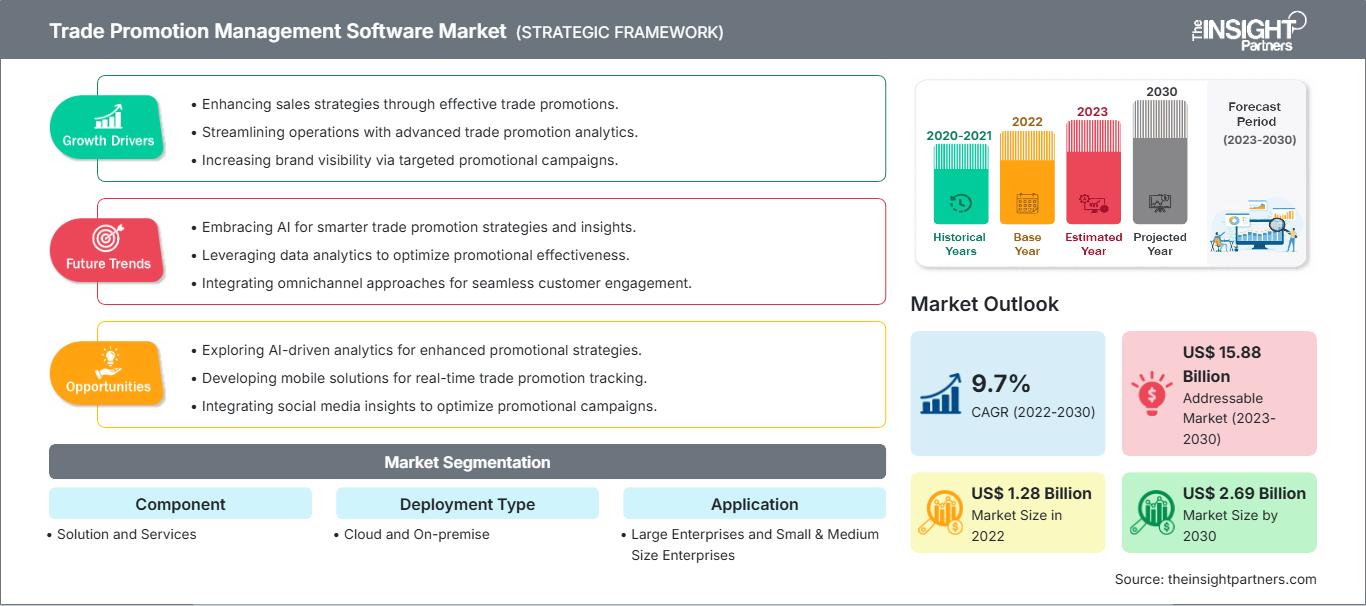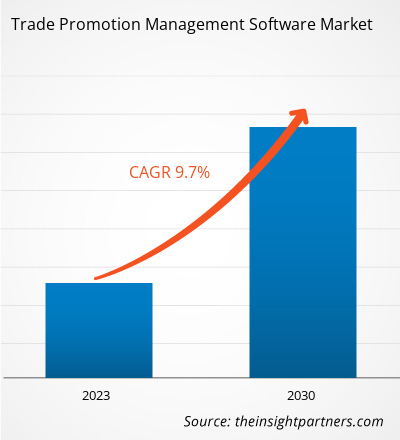[調査レポート] トレードプロモーション管理ソフトウェア市場規模は、2022年に12億8,000万米ドルと評価され、2030年までに26億9,000万米ドルに達すると見込まれています。トレードプロモーション管理ソフトウェア市場は、2022年から2030年にかけて9.7%のCAGRを記録すると予測されています。
アナリストの視点:
トレードプロモーション管理ソフトウェア市場は、幅広い関係者、テクノロジー、ソリューションを網羅する複雑で進化し続けるエコシステムです。このエコシステムの中核を成すのは消費財(CG)企業で、彼らはトレードプロモーション管理ソフトウェアを使用して、小売業者や卸売業者とのトレードプロモーションを管理しています。これらのプロモーションは、価格割引、クーポン、ディスプレイ、広告として提供できます。トレードプロモーション管理ソフトウェアの主なユーザーであるCG企業は、これらのソリューションを利用してトレードプロモーションの計画、実行、効果の追跡を行っています。小売業者と卸売業者は、販売時点におけるトレードプロモーションの実施と実行において重要な役割を果たすため、トレードプロモーション管理プロセスに不可欠なパートナーです。さまざまな企業がトレードプロモーション管理ソフトウェアソリューションを提供しており、あらゆる規模と業種のCG企業の特定のニーズに応えています。CG企業は、売上を伸ばし、利益率を改善し、拡大し続ける消費財業界で競争上の優位性を獲得するのに役立つトレードプロモーション管理ソリューションをますます求めています。
トレードプロモーション管理ソフトウェア市場の概要:
トレードプロモーション管理ソフトウェアは、組織がトレードプロモーションキャンペーンに関連する業務の戦略立案、計画、実行、管理を行うために使用するツールです。トレードプロモーションソフトウェアを利用する目的は、収益を増やし、利益を最大化することです。このソフトウェアは、メーカーだけでなく小売業者やベンダーによっても、価格戦略、製品ディスプレイ、オファーなどのさまざまな戦略を活用するために使用されます。割引。
トレードプロモーション管理ソフトウェア市場の成長は、世界の一人当たりGDPの増加と現代的ライフスタイルの適応による消費財産業の成長に起因しています。さらに、生産・販売計画のための需要と供給の力関係を分析することにより、様々な業界分野においてデータに基づいた意思決定を行う必要性が高まっていることも、トレードプロモーション管理ソフトウェア市場の成長を後押しする要因の一つです。しかしながら、一部の発展途上国および後発開発途上国におけるトレードプロモーション管理ソフトウェアの導入不足が、市場の成長を阻害しています。さらに、COVID-19パンデミックは市場の成長にわずかな影響を与えています。
要件に合わせてレポートをカスタマイズ
レポートの一部、国レベルの分析、Excelデータパックなどを含め、スタートアップ&大学向けに特別オファーや割引もご利用いただけます(無償)
トレードプロモーション管理ソフトウェア市場: 戦略的洞察

-
このレポートの主要な市場動向を入手してください。この無料サンプルには、市場動向から見積もりや予測に至るまでのデータ分析が含まれます。
トレードプロモーション管理ソフトウェア市場の牽引役:
トレードプロモーション業務のデジタル化がトレードプロモーション管理ソフトウェア市場の成長を促進
トレードプロモーションのデジタルトランスフォーメーションは、消費財(CPG)企業が迅速に適応し、収益を向上させ、最高の利益率を維持するための基盤となります。デジタルトレードプロモーション管理戦略を成功させるには、綿密で多面的な、データ主導のアプローチが不可欠です。企業は組織内でトレードプロモーションを効果的に管理する必要がありますが、長期的な成功には小売業者とのパートナーシップが重要です。FMCG企業と小売業者の間で相互に利益のある契約を結ぶことは、両社の信頼と成長を促進します。収益管理、財務、マーケティングなど、トレードプロモーション業務に関与する複数の部門の連携も不可欠です。プロセスの効率性と成功を保証するには、オーナーシップと説明責任、そしてインセンティブが不可欠です。各トレードプロモーションのライフサイクルを追跡する必要があります。計画された販促活動が実施されているかどうかを確認するために、実店舗を訪問し、ePoS(電子販売時点情報管理)データと情報を照合する必要もあります。分析アプリケーションは、内部データと外部データの両方を活用する必要があります。自動化された高度な統計分析ツールは、トレードプロモーション活動の特定の部分に関する詳細な洞察を提供し、企業がアプローチを微調整するのに役立ちます。これらのデジタル戦術の結果、FMCG組織は各顧客とのネットワークを継続することができます。このように、トレードプロモーション業務のデジタル化の進展は、トレードプロモーション管理ソフトウェア市場の成長を後押しします。
トレードプロモーション管理ソフトウェア市場レポートのセグメンテーションと範囲:
コンポーネントに基づいて、トレードプロモーション管理ソフトウェア市場はソリューションとサービスに分割されます。導入タイプに基づいて、トレードプロモーション管理ソフトウェア市場はクラウドとオンプレミスに分かれています。アプリケーションの観点から、トレードプロモーション管理ソフトウェア市場は大企業と中小企業に分かれています。業界別に見ると、トレードプロモーション管理ソフトウェア市場は、小売・消費財、IT、製薬、製造業などに分類されています。地理的には、世界のトレードプロモーション管理ソフトウェア市場は、北米、ヨーロッパ、アジア太平洋(APAC)、中東・アフリカ(MEA)、南米(SAM)の5つの主要地域に分かれています。
トレードプロモーション管理ソフトウェア市場セグメント分析:
アプリケーション別に見ると、トレードプロモーション管理ソフトウェア市場は大企業と中小企業に分かれています。大企業セグメントは2022年に大きなトレードプロモーション管理ソフトウェアシェアを占め、中小企業セグメントは予測期間中に高いCAGRを記録すると予想されています。従業員数が500人を超える組織は大企業に分類されます。大企業は様々な地域に顧客を持ち、大きな市場シェア、技術力、そして効果的なビジネス戦略を有しています。これらの大企業は通常、ビジネスを効果的に運営するために最新かつ革新的なテクノロジーに投資しています。過去数年間、様々な業界でトレードプロモーション管理ソフトウェアツールの機能が拡大するにつれ、こうしたツールの導入が広がっています。大企業は、トレードプロモーション管理ソフトウェアなどの様々な分析ツールを活用して、業務運営を効果的に効率化しています。
トレードプロモーション管理ソフトウェア市場の地域分析:
北米のトレードプロモーション管理ソフトウェア市場規模は、2022年には4億8,182万米ドルと評価され、2030年までに9億3,807万米ドルに達すると予測されています。また、2022年から2030年にかけて年平均成長率(CAGR)は8.7%と見込まれています。北米のトレードプロモーション管理ソフトウェア市場は、米国、カナダ、メキシコに分かれています。2022年には、北米のトレードプロモーション管理ソフトウェア市場で米国が最大のシェアを占めました。
米国、カナダ、メキシコは、北米の主要経済国です。この地域の様々な小売事業者は、先進的な技術ソリューションに多額の投資を行い、前年比で高い投資収益率(ROI)を実現しています。この地域、特に米国の消費者は食料品に多額の支出をするため、多くの小売スタートアップ企業が北米市場に参入しています。また、小売業者とテクノロジー企業は、新規顧客を獲得し、既存の顧客を維持するためのプロモーション活動に多額の投資を行うために協力しています。
北米では、消費財企業がトレードプロモーション管理ソリューションの主要なエンドユーザーです。この地域には、コカ・コーラ、ネスレ、ペプシコ、プロクター・アンド・ギャンブル、フィリップモリス、ロレアル、クラフトフーズといった老舗の消費財企業が存在します。こうした大手消費財企業の存在により、プロモーション活動への支出は増加しています。消費財セクターにおける競争力を維持するために、これらの企業はブランドイメージの向上と売上促進を目的とした広告やその他のプロモーション活動に継続的に投資しています。
北米では、トレードプロモーション管理ソリューションを提供する企業の足跡が見られました。例えば、Adesso はトレード プロモーション管理ソリューションを通じて、顧客のトレード プロモーション管理と効果の向上を支援しています。このソリューションは、北米の中小規模および新興の消費財メーカーにとって効率的です。したがって、トレード プロモーション管理ソリューション プロバイダーの足跡と北米の消費財セクターの成長により、トレード プロモーション活動を効率的かつ効果的に管理するためのトレード プロモーション管理ソフトウェアの需要が生まれると予測されています。
トレード プロモーション管理ソフトウェア市場の主要プレーヤー分析:
Aera Technology、TELUS、o9 Solutions, Inc.、Oracle、SAP SE、UpClear、Anaplan, Inc.、Aforza Inc.、Wipro、および Psignite Inc は、トレード プロモーション管理ソフトウェア市場で事業を展開している主要企業です。
トレードプロモーション管理ソフトウェア市場
予測期間全体を通してトレードプロモーション管理ソフトウェア市場に影響を与える地域的な傾向と要因については、The Insight Partnersのアナリストが詳細に説明しています。このセクションでは、北米、ヨーロッパ、アジア太平洋、中東・アフリカ、中南米におけるトレードプロモーション管理ソフトウェア市場のセグメントと地域についても説明します。
トレードプロモーション管理ソフトウェア市場レポートの範囲
| レポート属性 | 詳細 |
|---|---|
| の市場規模 2022 | US$ 1.28 Billion |
| 市場規模別 2030 | US$ 2.69 Billion |
| 世界的なCAGR (2022 - 2030) | 9.7% |
| 過去データ | 2020-2021 |
| 予測期間 | 2023-2030 |
| 対象セグメント |
By コンポーネント
|
| 対象地域と国 |
北米
|
| 市場リーダーと主要企業の概要 |
|
トレードプロモーション管理ソフトウェア市場のプレーヤー密度:ビジネスダイナミクスへの影響を理解する
トレードプロモーション管理ソフトウェア市場は、消費者の嗜好の変化、技術の進歩、製品メリットへの認知度の向上といった要因によるエンドユーザーの需要増加に牽引され、急速に成長しています。需要の増加に伴い、企業は提供内容の拡充、消費者ニーズへの対応のための革新、そして新たなトレンドの活用を進めており、これが市場の成長をさらに加速させています。

- 入手 トレードプロモーション管理ソフトウェア市場 主要プレーヤーの概要
トレードプロモーション管理ソフトウェア市場の最近の動向:
トレードプロモーション管理ソフトウェア市場では、合併や買収などの無機的および有機的な戦略が企業に広く採用されています。最近の主要なトレードプロモーション管理ソフトウェア市場の動向をいくつか以下に示します。
- 2023年1月、Oracleは一連の新しいクラウド機能を発表しました。Price HubはOracle Retail Merchandising Cloud Servicesを拡張して価格設定プロセスを自動化し、小売業者がさまざまな製品の購入価格を簡単に更新して売上と利益を最大化できるようにします。Oracle Retail Customer Engagement Cloud Servicesの新しいプロモーション機能は、小売業者がよりパーソナライズされた魅力的なオファーを実行することで、収益と収益性を向上させるのに役立ちます。クラウドサービスはOracle Cloud Infrastructure(OCI)上で実行されています。
- SAPは2022年2月、SAP Trade Promotion ManagementのFeature Pack 6をリリースし、消費者向け製品の販売プロセスにおけるSAPのリーダーシップをさらに強化しました。
- 2020年9月、TELUSはAFS TechnologiesおよびExceedraと協力し、さまざまなビジネス上の課題に対処しました。同社は、リアルタイムの情報アクセスの確保から、市場投入までの最終段階の最適化、棚スペースの確保、顧客との即時的なつながりまで、常にお客様の可能性をサポートすることに尽力してきました。
- 過去2年間の分析、基準年、CAGRによる予測(7年間)
- PEST分析とSWOT分析
- 市場規模価値/数量 - 世界、地域、国
- 業界と競争環境
- Excel データセット
最新レポート
関連レポート
お客様の声
購入理由
- 情報に基づいた意思決定
- 市場動向の理解
- 競合分析
- 顧客インサイト
- 市場予測
- リスク軽減
- 戦略計画
- 投資の正当性
- 新興市場の特定
- マーケティング戦略の強化
- 業務効率の向上
- 規制動向への対応






















 無料サンプルを入手 - トレードプロモーション管理ソフトウェア市場
無料サンプルを入手 - トレードプロモーション管理ソフトウェア市場